

设计单位 尌林建筑设计事务所
项目地点 陕西汉中
建成时间 2022年7月
建筑面积 380平方米
本文文字由设计单位提供。
▲ 项目视频 ©尌林建筑-丁诗颖
留坝位于秦岭以南,四季分明,气候宜人。服务中心作为留坝环山体景区的入口,坐落在留坝县城的一个山坳里。其主要功能包括为景区提供配套接待咨询、公共卫生间、文创产品售卖和书吧等服务。除此以外,这个服务中心还能作为周围村民的休憩场所,有着很强的开放性。
Liuba is located in the south of Qinling Mountains, experiencing four distinct seasons and pleasant weather. As the entrance to Liuba Mountain Scenic Area, the service center is located in a mountain lap in Liuba County. It mainly contains reception and consultation, public toilets, cultural and creative products sales, and a book bar not only providing a place for rest for the villagers, but also showcasing a strong sense of openness.




场地记忆
我们第一次到现场是4月的一个阴天,远山朦胧。现场有两幢横向的红砖房,它们在不同的标高上,呈60度角摆放。场地两侧的山挨得很近,给人一种强烈的被包裹感。我们从场地内空地朝山坳方向望去,只能看到屋顶之上的远山,整个场景很干净。
The first arrival was on a cloudy day in April. With hazy mountains at distance, the two horizontal red brick houses were placed at 60 degrees on different elevations, while the mountains on both sides seem close, giving a strong feeling of being surrounded. Looking along the lap to afar from the open space in the site, there is only very simple view of the distant mountains above the roof.




从现场的记忆中,我们提取出来最核心的两点要素:建筑的落位轴线以及看山的方式。新建筑在设计上延续了原有的建筑肌理和轴线,意在寻找原有场地的记忆。顺着山边的轴线,我们布局了一个体量作为卫生间。我们设计了一道特殊的墙体区分不同的功能和空间。上山的道路顺着墙体穿过建筑,方便游人使用。而石头墙体的左侧是接待公区和半室外公共空间,遵循另一条轴线布局。
From the on-site memory, two key elements are extracted: the axis of the architecture and the visual angle of the mountain. The new building inherits the original texture and axis, with the aim to retain the memory of the original site. A space is arranged along the axis of the mountain side as the toilet, and a special wall is used to separate the functional and spacial areas. The climbing road passes through the building along the wall for the convenience of tourists, and a reception area with semi outdoor public space are designed to the left side of the stone wall along the other axis.
建筑内部设计了多条流线,其中一条沿着建筑左侧,不经过建筑内部道路直接上山。另一种选择是进入建筑内部,这里有多条路径可以通行上山。为了实现纯粹的观山体验,我们设计了一片斜向的屋顶来引导人们的视线看向远山。我们在屋顶上设置一个观景平台,使人们能够登高望远和回看环山。
There are multiple motion lines in the building: one goes up directly along the left side of the building without passing the internal road of the building, while another enters the building before it diverses into multiple paths to go up to the mountain. The visual angle to the mountain is simple through a slanting rood, with a platform on the roof for those who climb high to look far into the surrounding mountains.




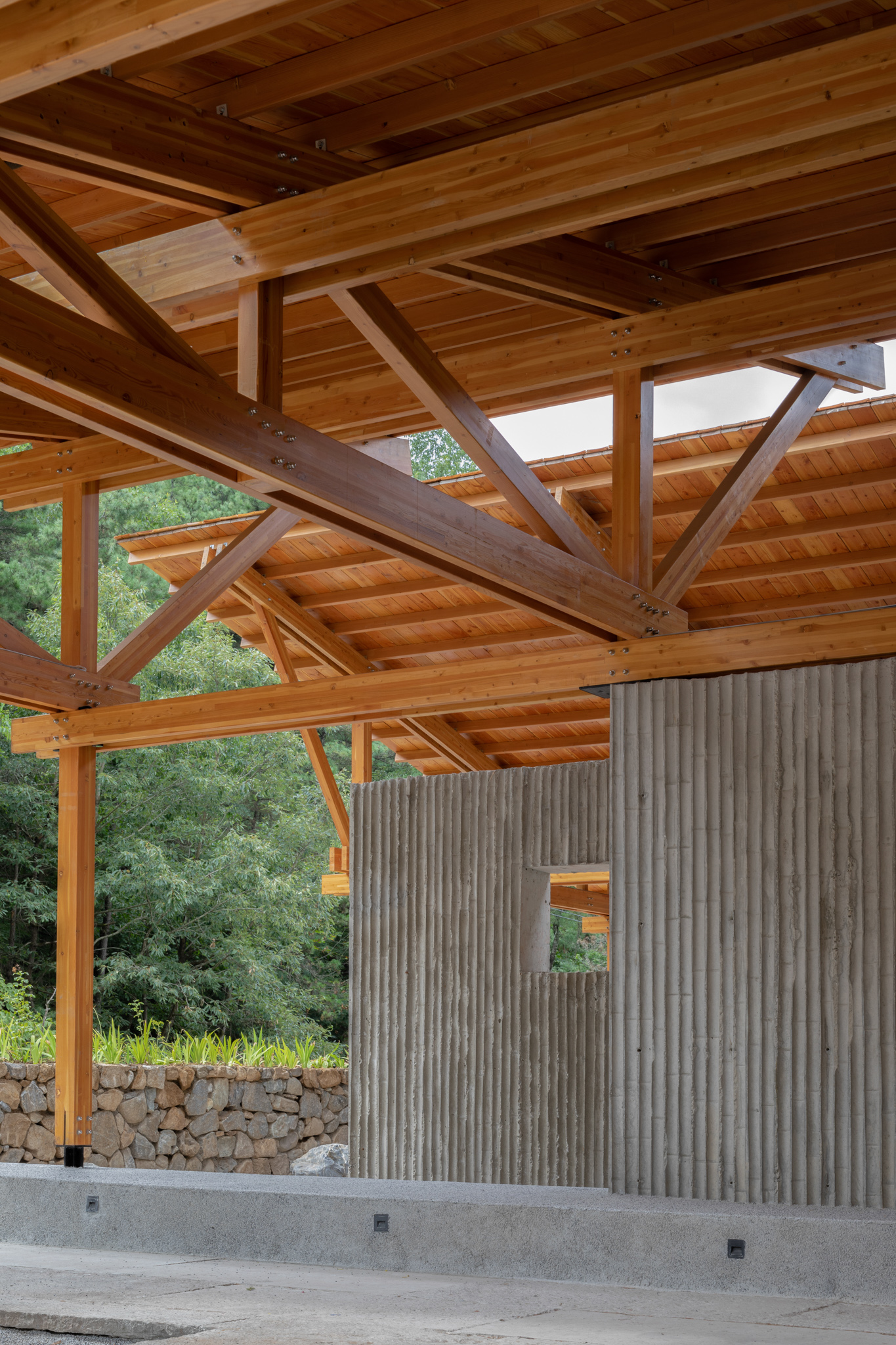
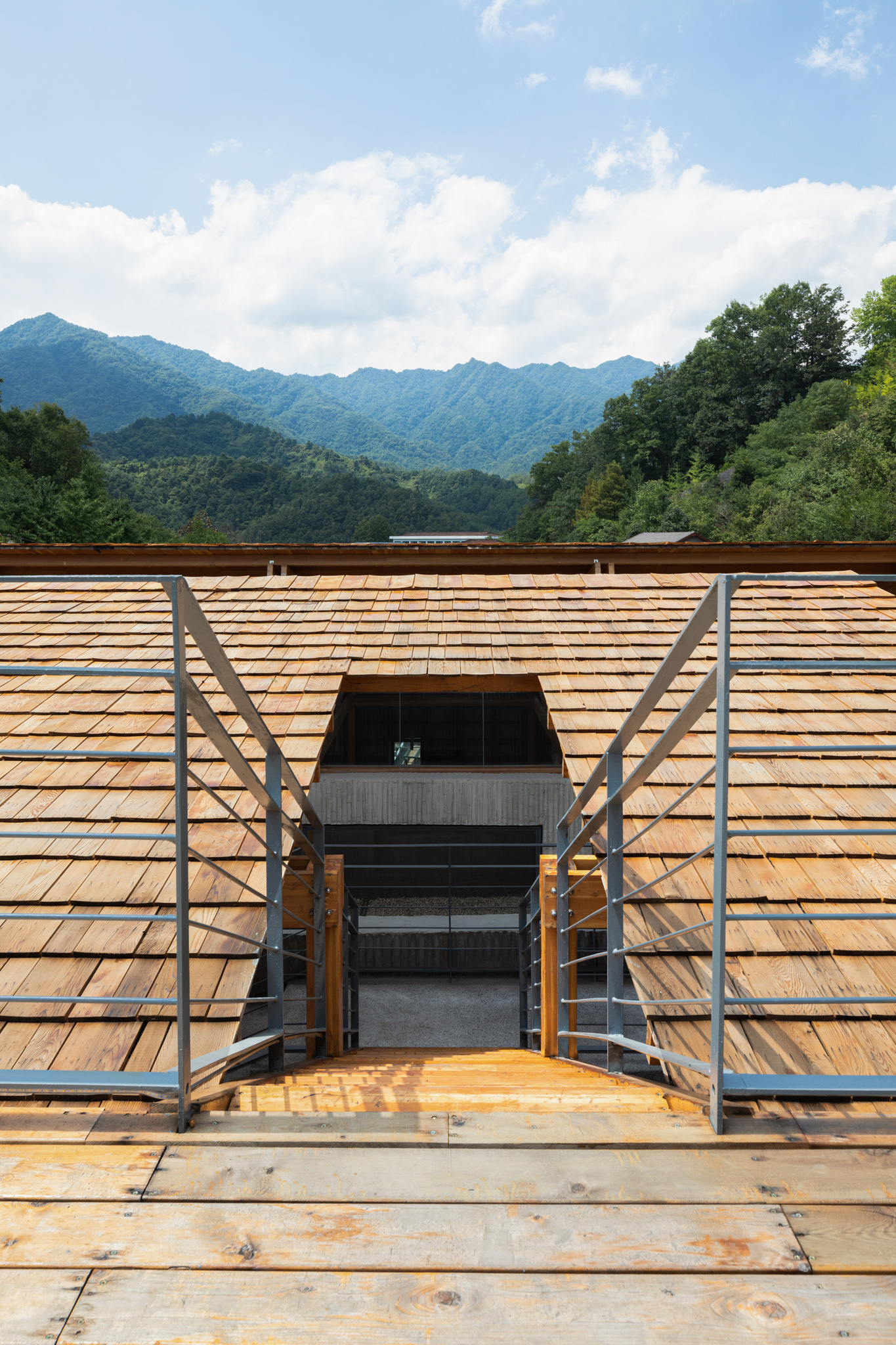
三片屋顶、一榀屋架、几片墙体
在建筑设计中,将房子的基本要素拆分得很清晰,包括屋顶、结构、墙体和地面。使用空间分布在三片大屋顶之下,分别是接待公区、开放的公共空间、公共卫生间,三个功能既相互独立又发生关联,有机地组织在一起。
The architectural design clearly separates the basic elements of the house, the roof, the structure, the walls and the ground. The functional spaces are distributed under three big roofs, namely the public reception, open public space and the public toilet, which are both independent and interdependent, and are systematically organized.





大屋顶是由预制化设计的胶合木结构屋架构建而成。这些屋架在不同尺度上,保持着相同的设计逻辑和形式,进行重复和演化。这种设计类似于中国传统的木构建筑,在连续阵列的屋架中呈现出多样性。我们首先研究了一榀标准屋架,然后将屋架进行阵列,根据空间尺度形成尺度上的变化,从而形成了三个基础的木结构屋架空间体系。
The big roof is built on prefabricated plywood roof truss at different scales that repeat and evolve from the coherent design logic and form, similar to the traditional Chinese wooden buildings, which changes within the continuous array of roof trusses. A standard roof truss is designed and repeated to be arrayed for scale change according to the space, and therefore, a spatial relation of three basic wooden roof trusses is created.


在整个设计过程中,我们一直希望这座建筑拥有清晰的建构逻辑,包括台基、墙体、木结构、楼梯和屋顶。台基作为场地基础要素得到还原,墙体和木结构体系的关系清晰,楼梯则顺应场地和墙体进行布置。三种材质的墙体的设计逻辑是沿着屋顶的走向展开。
From the very beginning, I hope to design a clear structural logic for the architecture, including the platform, the walls, the wood structure, the stairs and the roof.The design restores the platform foundation as the basic element of the site, clarifies the relation between the wall and the wood structure, and aligns the stairs with the wall, which also designs the walls of three different texture along the direction of the roof.


竹模混凝土现浇墙体与屋顶的长边方向平行设置,而短边则是用半透明的玻璃砖墙体填充并退于混凝土墙体之内。所有方形的洞口和窗户在竹模现浇墙体上,小方窗玻璃内退并安装开启扇,而大方窗则突出墙面,平外侧安装固定玻璃。至于门的设计,都开在玻璃砖墙体上,使用的是半透明长虹玻璃。
The cast-in-place bamboo formwork concrete wall is horizontally arranged in accordance with the direction of the long side of the roof, while the short side is filled with translucent glass brick walls which retreats behind the concrete wall. All square holes and windows are on the cast-in-place bamboo formwork wall, the small square window glass is retreated with open leaves, the large square window protrudes, and fixed glass is installed on the outside. The doors, made of translucent Changhong glass, open on the glass brick wall.


在三个屋顶之间,我们设置了一道斜向的垒砌毛石墙体,它转折穿插进入接待空间内部,形成一种有趣的交织关系。
An oblique masonry rubble wall between the three roofs is connected into the interior of the reception, forming an interesting interwoven relationship.
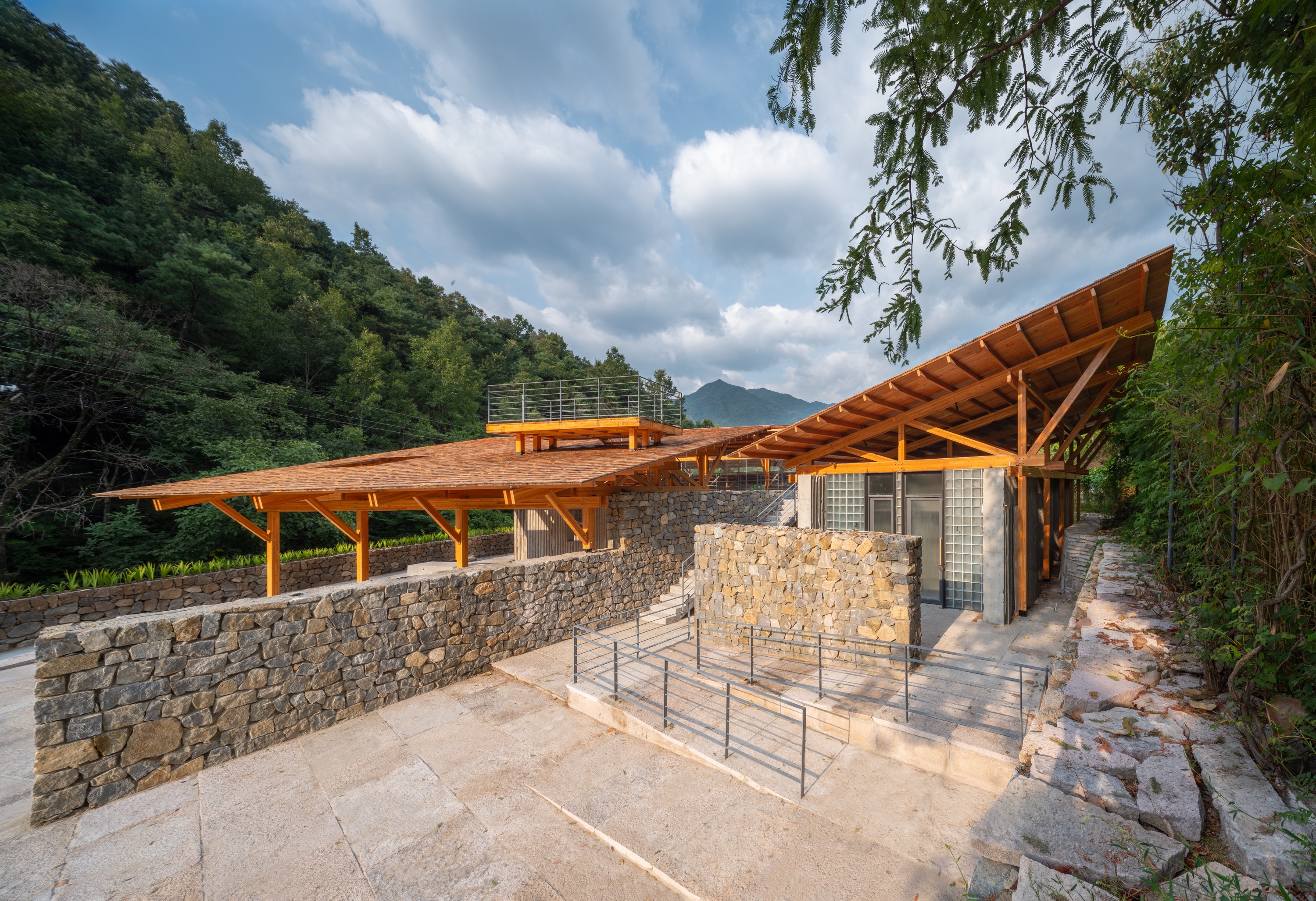


木结构柱网体系与墙体之间形成三种不同的内外交接关系。在接待公区,木结构柱网全部在墙体内侧,与墙体轴线相距400毫米,这种设计让墙体与结构分离。而在公共卫生间,木结构柱子则全部裸露在墙体外侧。至于开放的公共空间,木结构柱网与墙体同轴线布置,两者互相咬合在一起。
There are three different internal and external connections between the wood structure columns and the walls. The columns in the reception area is on the inside and 400 away from the wall axis, while the wall is separated from the structure. The wood structure columns in the public toilet are all exposed outside of the wall, while the wood structure in the open public space is occluded with the same axis of the wall.



这几种不同的交接关系并置存在,让空间之间的关系变得很有趣,同时,这也是在探讨建筑最基本要素——结构与墙体之间的组织逻辑。实际上,这几种组织方式在传统民居建造体系中都有应用过,各个系统之间的关系也十分清晰。在这个建筑中,我们对这几种关系进行了综合性的尝试,创造出了独特的空间体验。
All these relations bring more fun to the space,and explore the most basic elements of the building and the organizational logic between the structure and the wall. In fact, these kinds of organizational methods have been used in the traditional residential construction with clear relations in each system. We made attempts to combine these relations in this architecture.


肆意游走与时间性
当我们第一次进入这座完工后的房子中,感到一种莫名的兴奋,我们毫无目的地游走在多条路径和不同空间中,甚至在分叉口犹豫不决,不知道选择哪条路走。这种行走体验非常有趣,或许是受到多年前对苏州园林考察的影响,那些记忆在我们心中悄然产生了变化。
When I first stepped into the house, I felt an unexpected excitement. It’s a very interesting experience to wander about aimlessly through various paths and different spaces, not knowing where to go at the intersections. The inspiration might come from the implicit memory of Suzhou garden I visited many years ago.

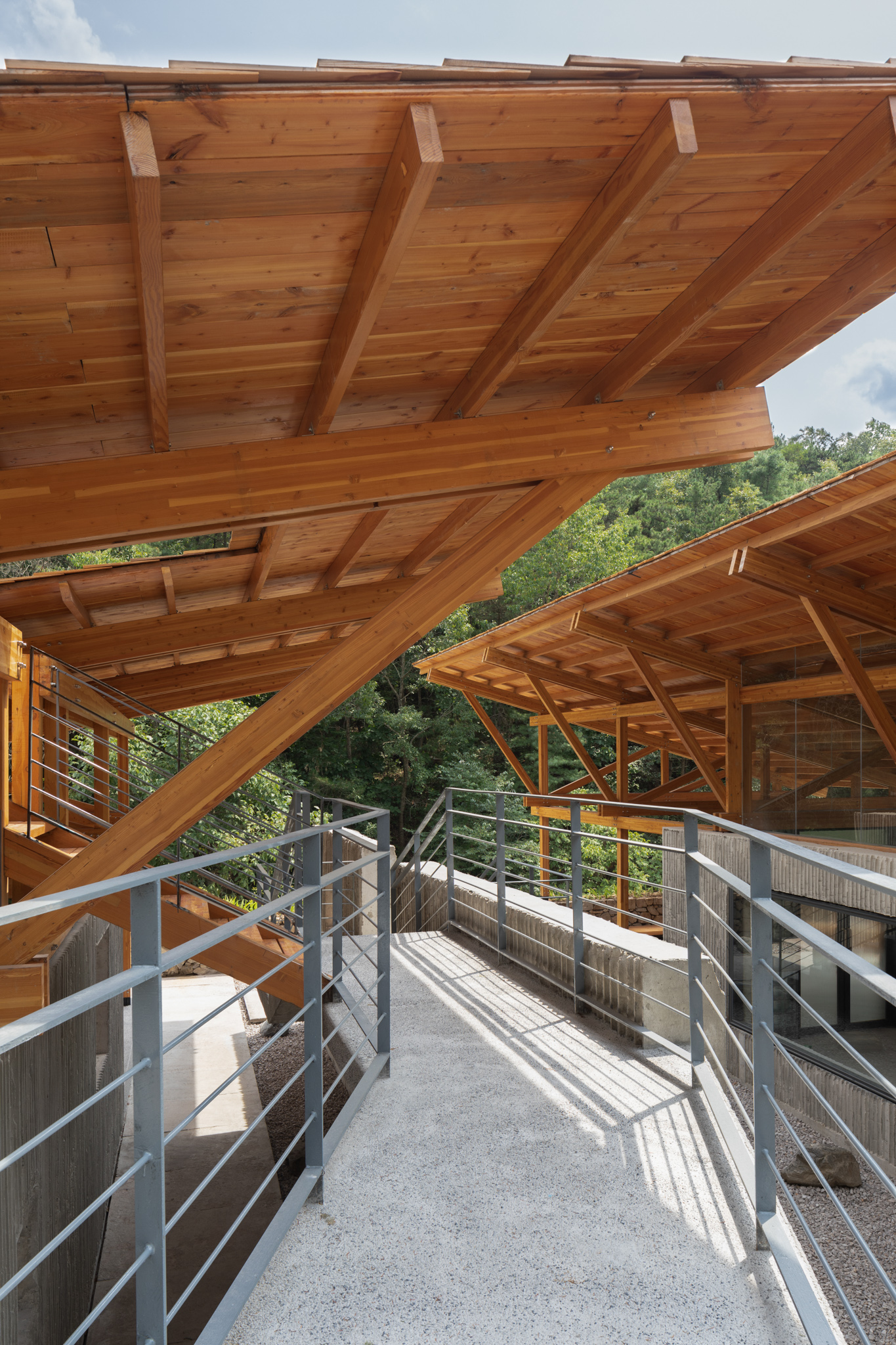

我们在建筑内设置了多条路径,创造了丰富的游走体验。由于场地的高差关系,几个空间位于不同的标高上,因此自然地形成了坡道和上下台阶的联系。为了更好地欣赏远山,我们设计了一条通往屋顶平台的路径。这条路径沿着墙体穿插在三个屋顶之间,构成了上上下下的游廊体验。游客可以穿过一个敞开的屋顶洞口,登上屋顶的架空平台。在空间中,人们的行走路径被有意地限定和引导,同时又提供多种选择,这种游走的状态让人仿佛可以忘记时间。
Multiple paths in the building create a special walking experience. As the height difference set several spaces at different elevations, the space naturally forms slopes and stairs. For better view of the distant mountains, we set a path to the roof interspersed between three roofs along the wall. The veranda goes up and down, passes an open roof entrance and extends to the overhead platform, which is deliberately limited and guided in the space, but also left with many choices at one time to erase the sense of time during wandering.
无目的地游走、多种可选择的路径以及空间的高低转折变化,这使得有用与无用相得益彰。这种体验是不是一种时间性,我们不得而知。
The aimless wander can take many alternative paths, with changes in heights, combined by usefulness and uselessness to represent sense of time.



趣味
当人的身体和视线随着空间的转折和引导发生变化时,惊喜会不断涌现。墙体和屋顶在空间中交织交错,形成非正交的组织关系,从而创造视觉上的错位感。当我们看向两片墙体之间的洞口,能看到不同的景象。在某个空间角度,窗口会斜向重叠,使得空间被层层叠合,窗口内看到的层次感变得丰富和聚焦。当你在不经意中发现这些观看角度的时候,这种趣味性就产生了。
Fun is a widely discussed topic. As people's body and sight change with the turning and guidance of space, surprises will be generated uninterruptedly. The interwoven walls and roofs form an informal relation to create visual dislocation. From the hole between the two walls, different contents are presented. At a certain angle in the space, the windows will overlap diagonally, and the will be stacked layer by layer, which brings richer and more focused views. When these perspectives are notied, the fun arise.
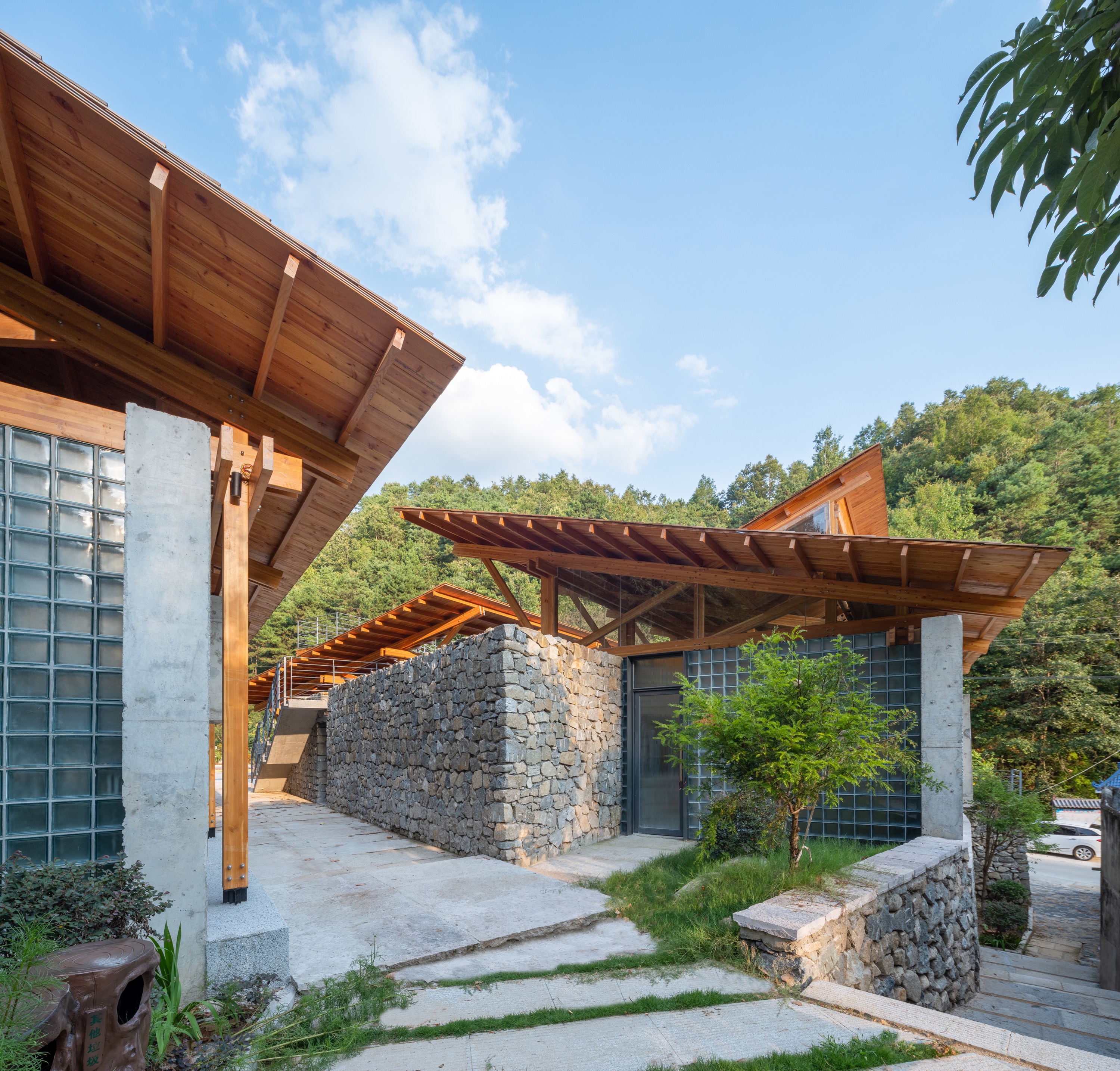



不同层次的灰:细腻与粗犷的交融
在材料运用方面,我们主要选择了暖色的木头和灰色的水泥和石材。暖色主要出现在建筑的上半部分,而灰色则主要出现在建筑的下半部分。建筑的主体结构材料采用小尺寸的花旗松胶合木,同时花旗松望板和红雪松木瓦组建成屋顶体系,都是暖色系材质。在墙体和地面则使用灰色,我们采用了竹模现浇混凝土墙体、水洗石台阶、老石板室外铺地、水磨石室内地面,形成了相近的灰色基调。玻璃砖墙体采用略带冷灰色的色调进行冷暖调和。这样的材质关系在细微的变化中既保持了相似性,又呈现出不同的质感。
Warm colored wood and gray cement and stone are mainly chosen for materials. Warm color appears in the upper part of the building, and gray dominates in the lower part.The building mainly uses small size Douglas fir plywood, and the Douglas fir watch board and red cedar shingles for a roof system are all warm colors. The walls and the ground are gray. The bamboo formwork cast-in-place concrete wall, washed stone steps, old slate outdoor paving, and terrazzo indoor ground form a similar gray tone. The glass brick wall is mixed with a little cold gray to balance the warmth of the color, as well as provide subtle changes of the similar materials and different texture.
铁艺栏杆、窗户和书架也属于灰色系,它们共同构建了建筑所带来的的质感和温度。在这座建筑中,我们希望构建粗糙和细腻的对比、暖与灰的调和、轻和重的穿插,以此形成建筑最基本的材料感知。
The iron railings for the window bookcases are also gray, which together build the texture and temperature of the building. We also hoped to present a contrast between the fine and the wild, harmony of the warm color and gray and combination of the light and the heavy to form the most basic material perception of the building.

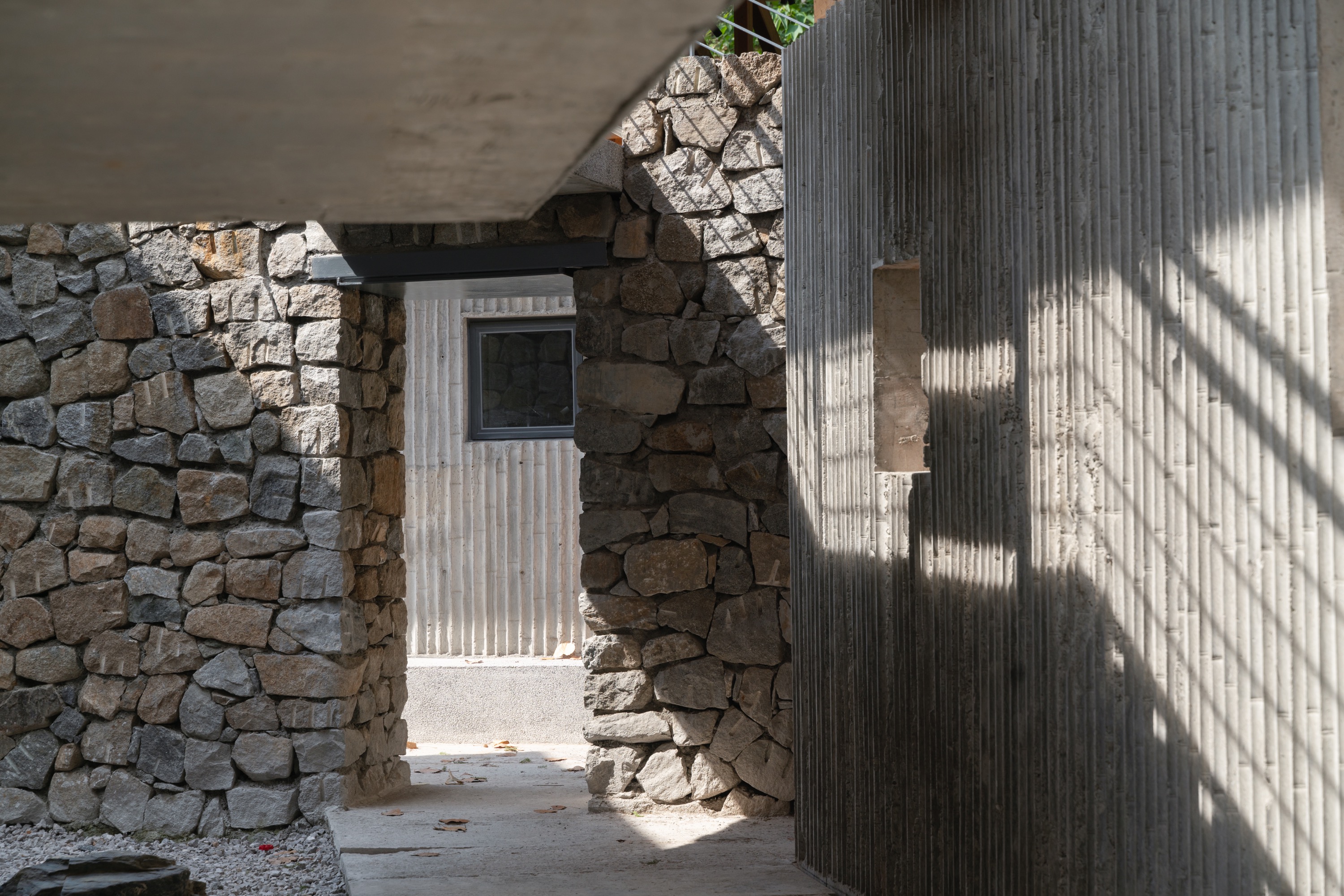


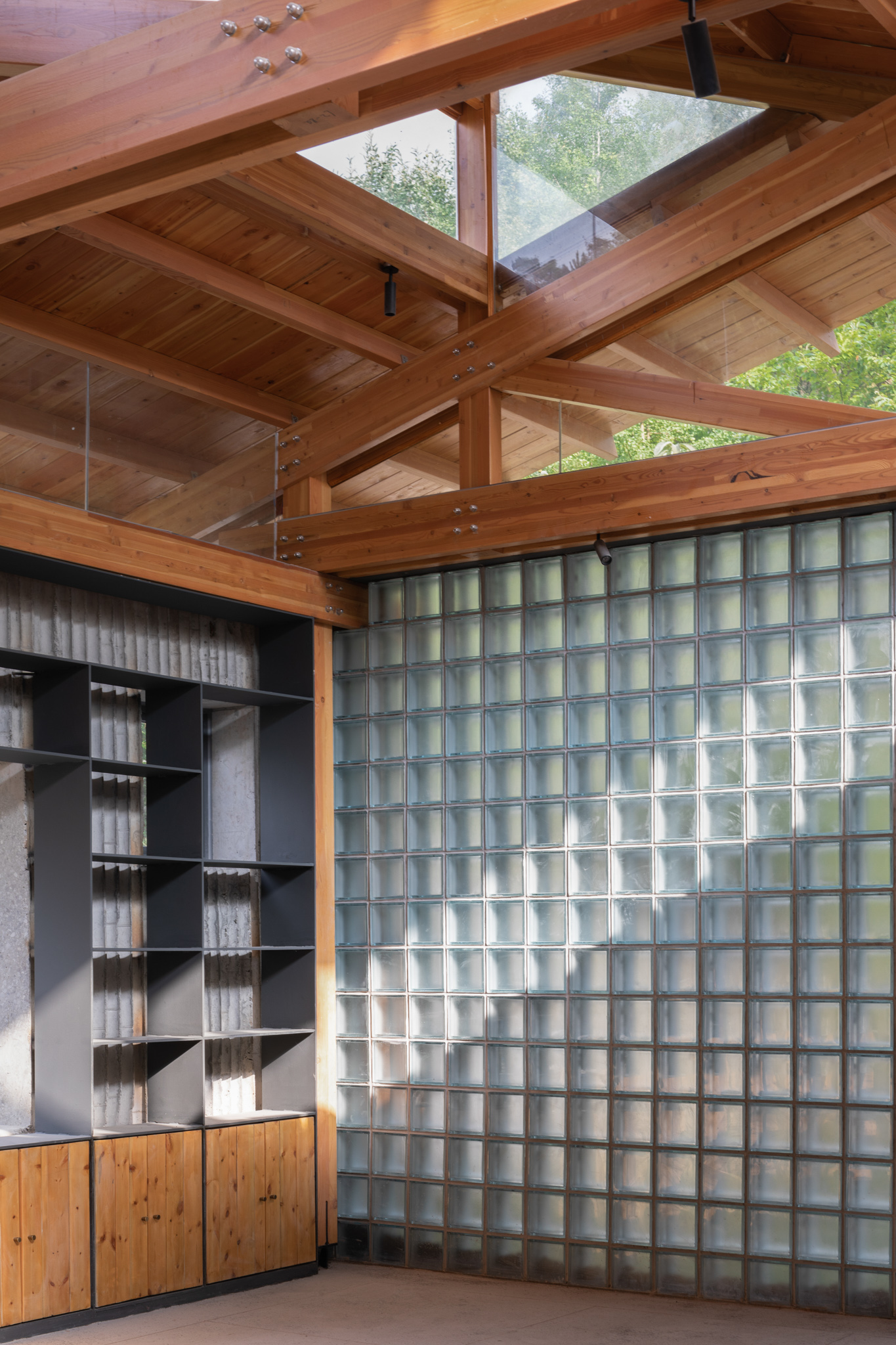

建筑给人的感受是通过空间、光影、材质、体验等多个维度综合展现的。材质之间的碰撞,不仅体现在颜色和光影上,还有质感和触觉。
The architecture influences people comprehensively through space, light and shadow, materials and experience. The collision between materials is not only in color, light and shadow, but also their texture and feel.
在建造过程中,我们曾对竹模混凝土的效果感到有些失落,其品质未达到我们最初的预期。然而,我们并没有急着进行修复,而是选择在进程中不断观察和调整。当木结构架起来,玻璃砖做好的时候,我们再回头看竹模混凝土的粗糙感,觉得不再是问题了。尤其在毛石垒墙完成后,竹模混凝土的质感进一步凸显,材料的层次感也更加明显。而光影照射在墙面上时,创造出的水纹投影尤其生动。
I was a little disappointed when the bamboo formwork concrete was just removed, as it didn’t turn out to be what I expected, but I didn't rush to repair. As the wood structure and glass bricks were donw, the roughness of the bamboo formwork concrete went just fine. After the rubble wall is built, the rough feeling of bamboo formwork concrete turned even better, with more layers of the textur and water line projections of light and shadows made it more vivid.



建筑的细腻与粗犷并存,高密度的细节可能会让人感到不适,而过于粗糙则可能使整体显得简陋。建筑师对于这种度的把握和关系的控制非常重要。同时,建筑师的个人感受也很关键,对现场做的每个决定都会影响建筑完成后的整体气质。
As fineness and roughness go hand in hand, high density of delicacy is usually overwhelming, while roughness without details bores people. The proportion and the control of the relation as well as the architect’s personnal feeling are important, while every decision made on the site will affect the overall quality of the building after completion.


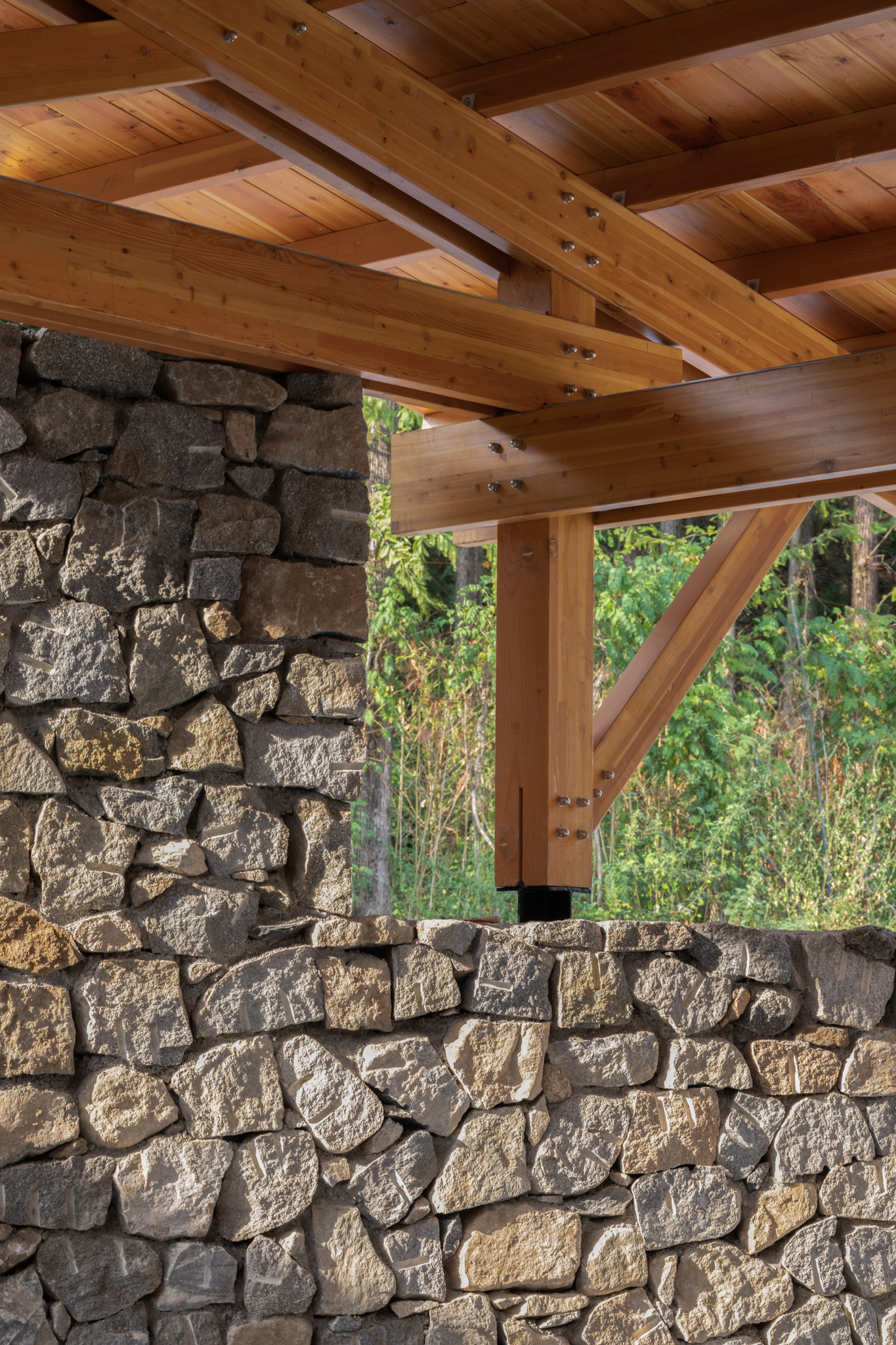
感觉与逻辑
我们在方案的创作过程是很快的,但建造过程却会在材料和细节上产生纠结。实际实施中,方案往往会与最初的构想有所不同。设计的语言以严密的逻辑为基础,思路明晰,手法清楚,同时也需要保留一些模糊和变化的感觉。我们希望使用者能够体验到设计的意图,但又不愿意将所有内涵传达得过于直白。在这个项目中,设计逻辑的清晰与个人感觉的模糊共同存在。
The design didn’t take much time, but during the construction, we spent much time on the meterials and details, and sometimes the reality turned out different from what we expected. The language of design is based on logic with clear ideas and techniques, but also sense of fuzzy changes. We hope that the designs and connotations are sensed, not straight fowardly illustrated to the users. The clarity of design logic and the ambiguity of personal feeling coexist in this project.




设计逻辑是偏理性的,空间感受又是偏感性的。比如,在游廊栏杆的处理上,我们纠结了很久。我们在模型中模拟了多种形式,最终决定使用轻质灰色的铁艺栏杆,以减弱其存在感,并将其融入整体的灰色色调中。在创作过程中,思维常常在理性与感性之间游走。甚至在建造的过程中也是如此。最终的决策常常是逻辑与感觉之间反复斗争的结果。
The design logic is rational, and the feeling of the space relates more to the emotion. I put a lot of thoughts into the veranda railings, and simulated various forms during modeling, but ended up with light gray iron railings to weaken the sense of existence and integrate them into the overall gray background. I always go back and forth during the design and even the construction, but what is left would be the result of back and forth struggle between logic and feeling.




被公共使用
在我们的作品中,公共性是一个受到关注和探讨的主题,在这座建筑中,公共开放的特性也得到了充分考虑。建筑纯室内的面积很少,大部分空间处于一种开放的状态,为人们提供了选择的自由。人们可以随意选择坐下休憩、聊天,而且公共卫生间24小时开放,整个空间允许人们自由穿梭游走。
Being public is a constant concern and discussion in our works, and the same goes to this architecture. There are few areas outside, and most of the space is open for people to sit and chat or walk randomly around, with a public toilet that opens 24-7.
傍晚时分,许多周边居民都驻留在这里聊家常。我们希望看到建筑建成的时刻是他生命的开始,而不是结束。当建筑被更高频的使用时,它的空间公共性才能充分被体现。
In the evenings, many residents who live around would stay and chat. We want the completion of the building a commencement rather than a closure, and only frequent use can make it public.

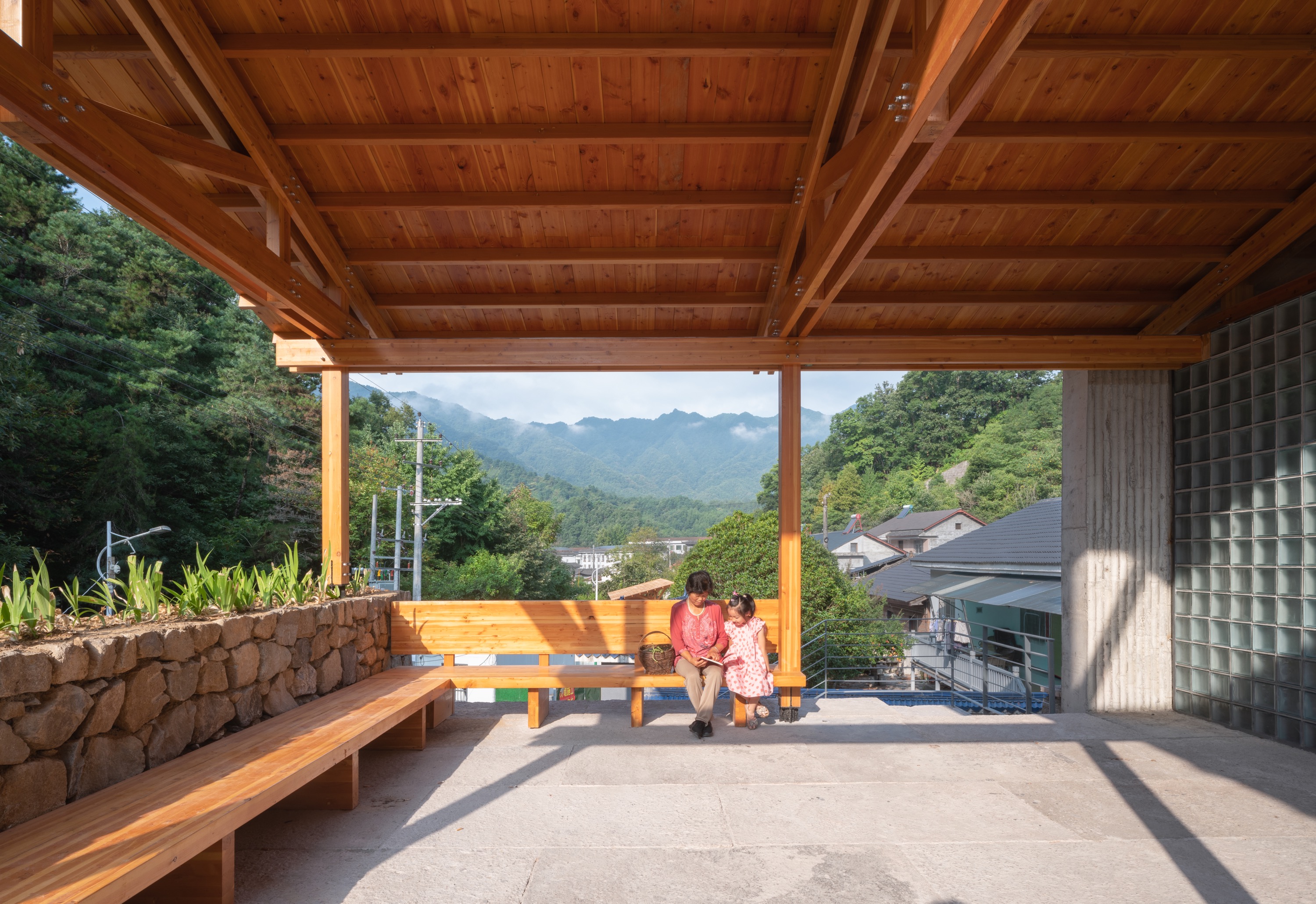

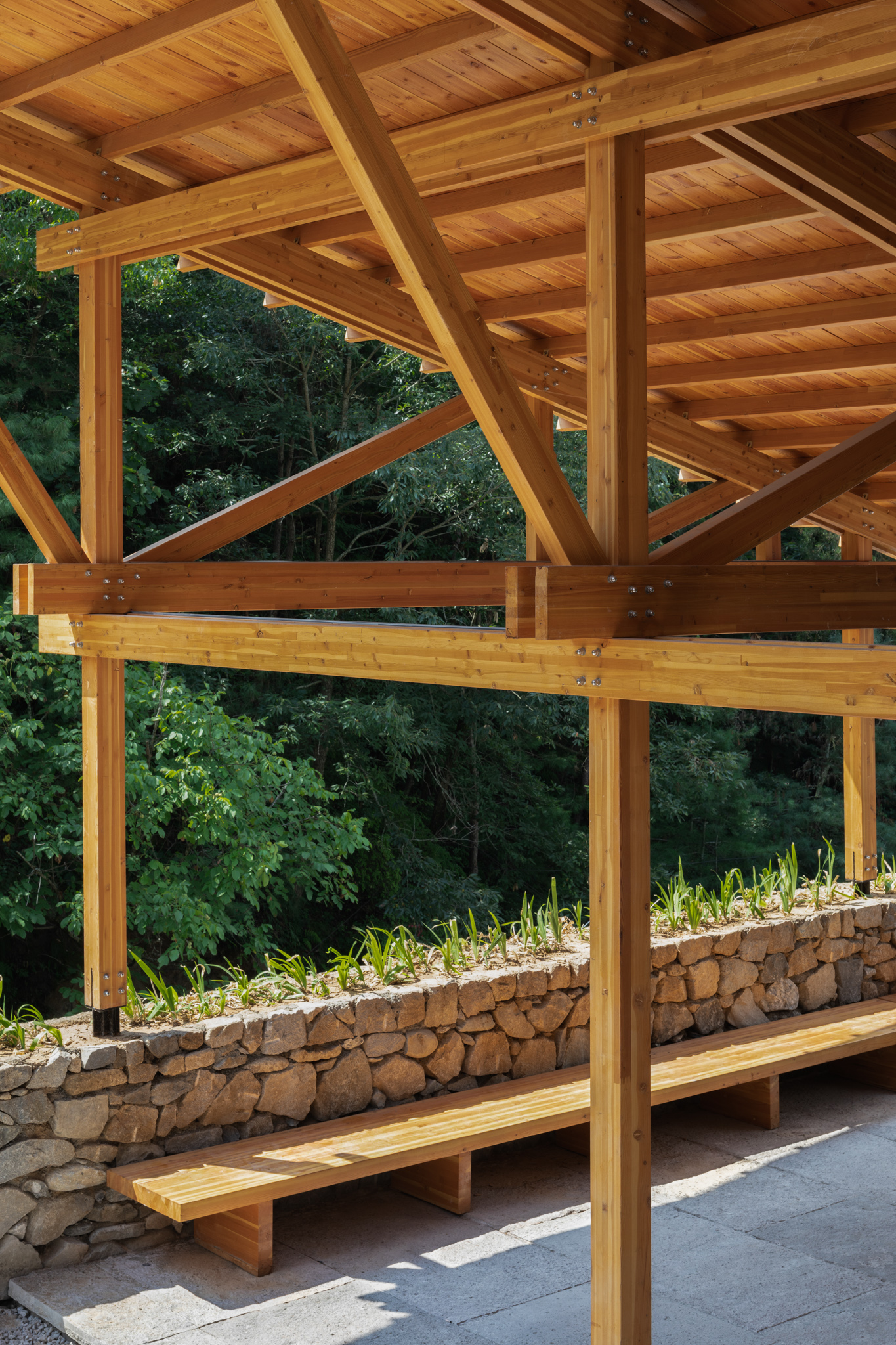

真实的建造
真实的建造过程能够深深打动人心。在事务所的实践作品中,始终追求着真实的建造,而这座建筑可以说是基本实现了这一目标。在设计初期,我便怀着用最真实清晰的思考方式进行设计的愿望。我希望所有建筑的空间、构造、材料以及交接关系都能得到清晰的展示和表达,避免任何过度装饰的做法。进入空间后,人们可以直观地想象整个建筑的建造过程。
Real construction will surely impress people, which is a constant pursuit for our firm and has been realized in this architecture. Since the very beginning, I hoped that we could use the clearest thinking to design all the spaces, structural materials and relations to clearly present and express without any decoration the whole process of construction when people enter the space.





石头从底部逐渐堆砌,混凝土在竹子支模板的支撑下逐渐浇筑,木结构则在工厂中加工并在现场进行组装,老石板一个个被铺设,玻璃砖则一个个被嵌入。这些步骤清晰地还原了整个建筑的建造过程。对我们而言,能够实现如此明确真实的建造表达,是这个项目中最大的收获。
Stones slowly pile up from bottom to top, concrete bamboo are cast on-site, wood structures are constructed on-site, old stone slabs are paved one after another and glass bricks are built one by one, which all help to restore the construction process. For me, the biggest achievement is exactly to provide such clear expression for the architecture.



设计图纸 ▽




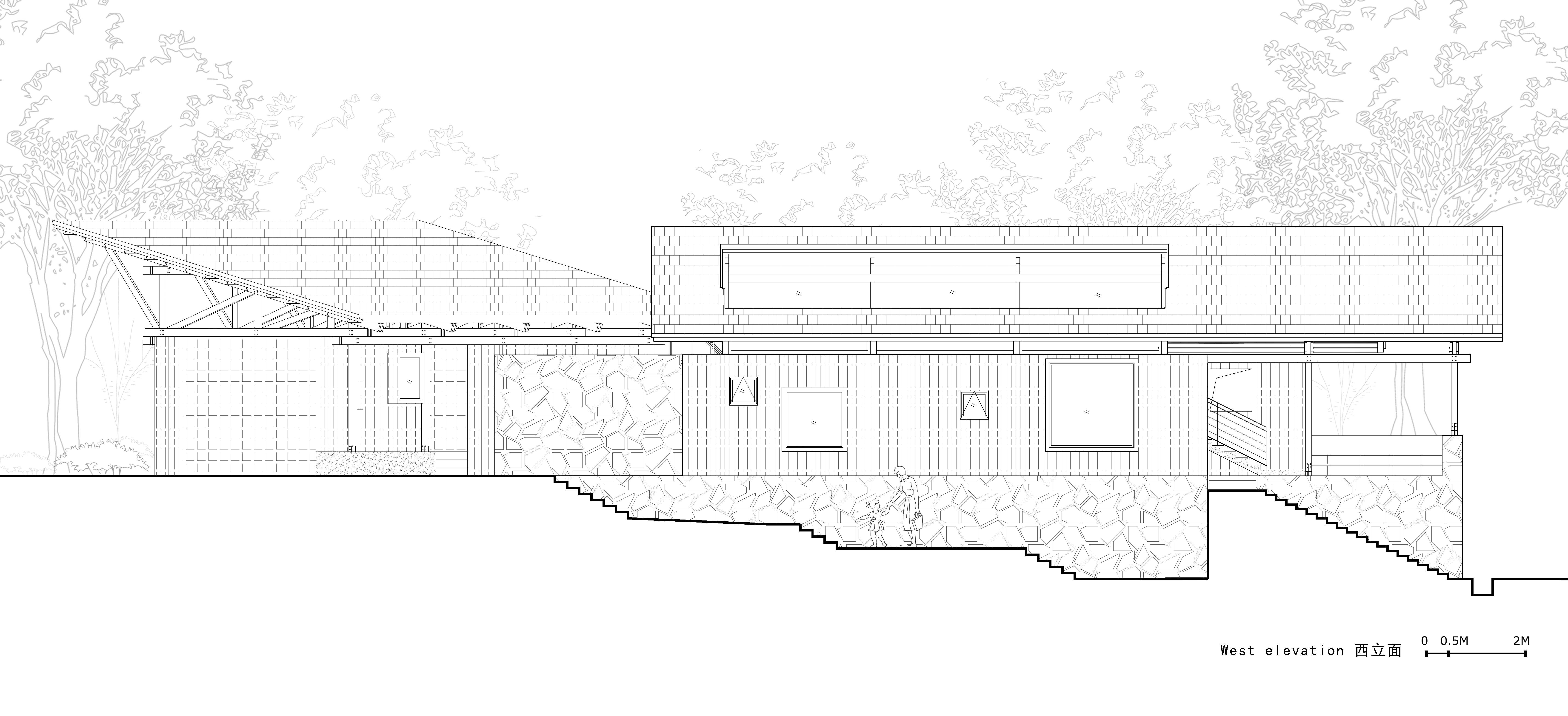
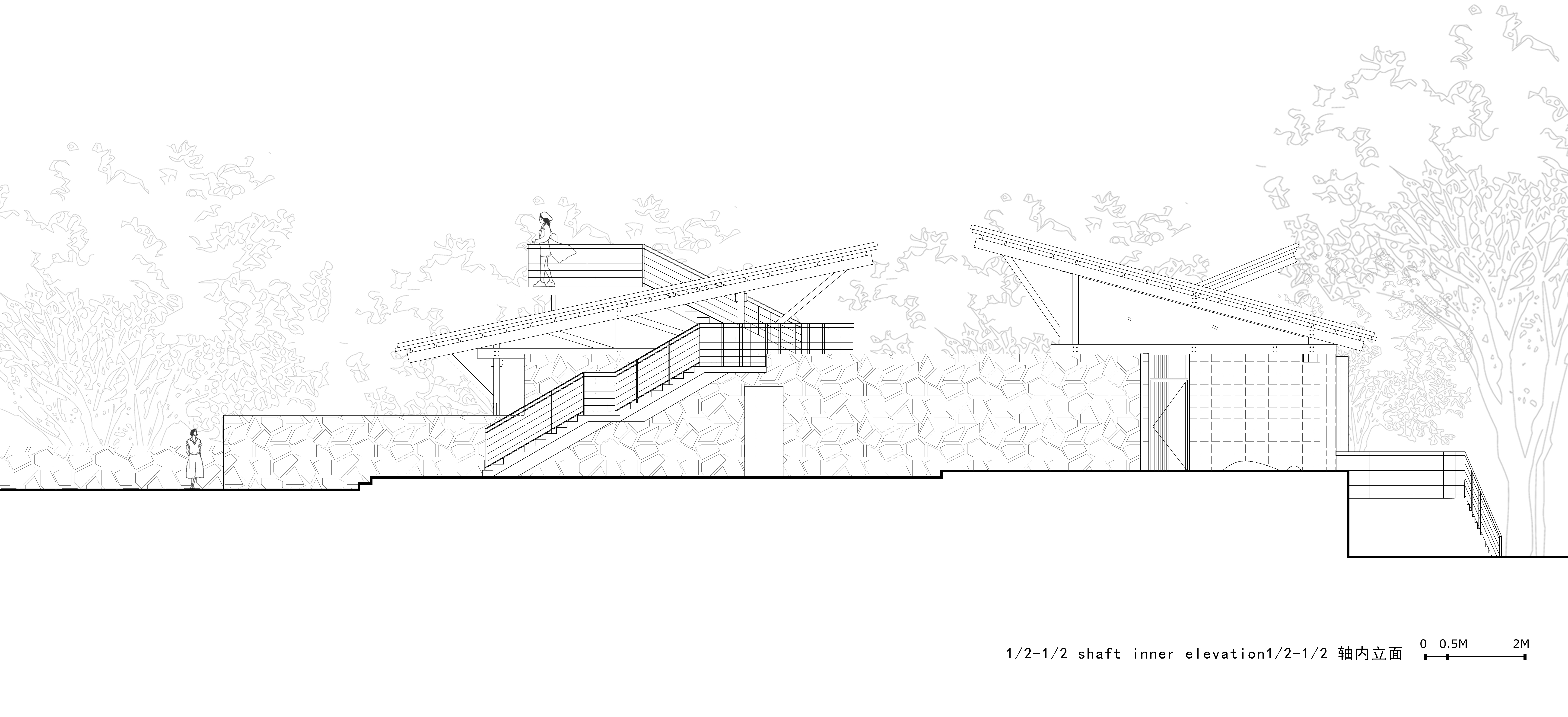

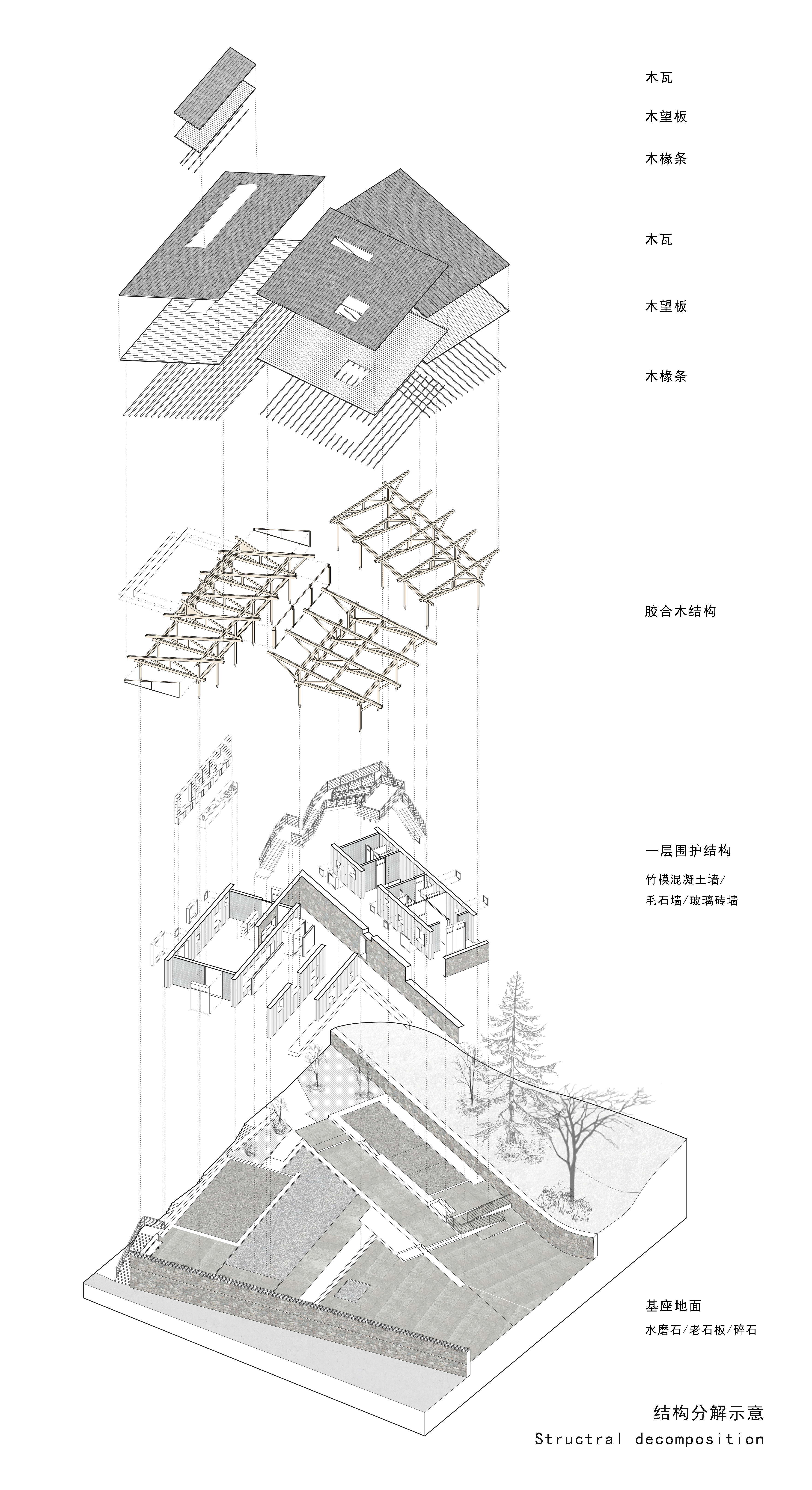



完整项目信息
项目名称:留坝瓦窑沟多功能服务中心
项目地点:陕西省汉中市留坝县瓦窑沟
项目业主:留坝县住房和城乡建设管理局
施工负责:杨猛
建筑设计单位:尌林建筑设计事务所
主持建筑师:陈林、刘东英
规划景观设计单位:林野(上海意希欧景观建筑设计有限公司)
室内设计师:王嘉欣
结构顾问:陆洋(栾栌构造设计事务所)
项目类型:公共服务接待配套
结构形式:木结构
设计时间:2021年6月
建成时间:2022年7月
建筑面积:380平方米
建筑材料:花旗松胶合木、竹模混凝土、毛石砌块、红雪松木瓦、玻璃砖、老石板、钢板、水洗石、水磨石
建筑摄影:赵奕龙、吴昂
视频拍摄:尌林建筑-丁诗颖
版权声明:本文由尌林建筑设计事务所授权发布。欢迎转发,禁止以有方编辑版本转载。
投稿邮箱:media@archiposition.com
上一篇:可移动立面格栅:马略卡大道15号公寓楼 / OHLAB
下一篇:中标方案 | 立体书院:燕罗街道燕川九年一贯制学校新建工程 / 深大建筑设计院-拾陌工作室